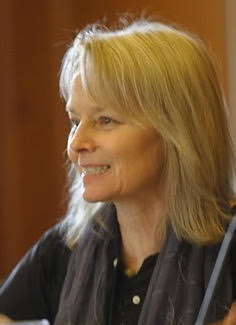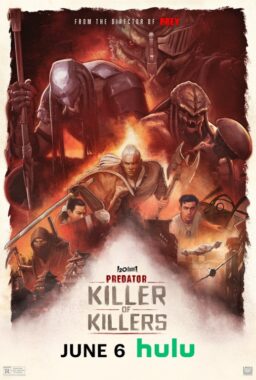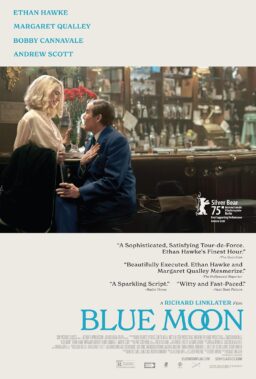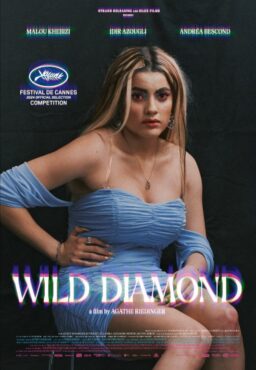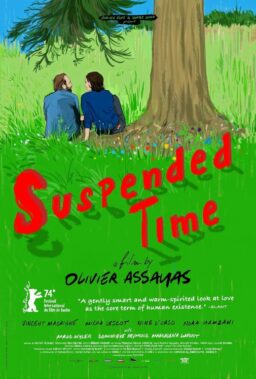 He had these smiling eyes. And a self-deprecating manner which seemed to belie his very good looks (“He’s so cute,” my 19-year-old assistant exclaimed), about which he was fairly oblivious. Most of all, he was simply a very good guy.
He had these smiling eyes. And a self-deprecating manner which seemed to belie his very good looks (“He’s so cute,” my 19-year-old assistant exclaimed), about which he was fairly oblivious. Most of all, he was simply a very good guy.
Gary Winick, a many-hats-wearing filmmaker and digital pioneer, died of complications following a 2 year battle with brain cancer on February 27th, the day of the Academy Awards — an especially sad irony for a vital man, weeks shy of 50, whose passion for film and storytelling had filled the decades of his adult life.
The private memorial service was held at the Time-Warner Center in Winick’s beloved New York. Overlooking Central Park as the sun set, an invited group of 400 (some going back to childhood, some famous, many with whom he’d worked, even some he’d made sure got a decent meal when they were struggling) assembled to watch film clips, to hear and tell stories – to cry, yes, but also to laugh at so many experiences they certainly cherish now.

Gary Winick at the American Film Institute
A VALEDICTION FORBIDDING MOURNING by John Donne
As virtuous men pass mildly away, And whisper to their souls to go, Whilst some of their sad friends do say, “Now his breath goes,” and some say, “No.”
Many obituaries appeared at the time; this is not one. This is a memory piece, a tribute to someone “very special” (his manager, Rosalie Swedlin) who was “so important to independent film” (producer Caroline Kaplan, “Letters to Juliet“).
I met Gary Winick at the American Film Institute in Los Angeles in the summer of 1989, where my temp job with the Independent Filmmakers Program had somehow morphed into reorganizing and managing distribution of the Masters’ thesis films created each year at the Conservatory.
Holding a VHS tape, Winick walked into the high-ceilinged, desk-crammed room, barely accommodating 9 staff focused on multiple, complicated projects. He may have been surprised to find so many – all women – glancing up as he asked about distribution. One of them, probably at work on “Hollywood Mavericks” (an AFIproduced documentary about nonconformist directors ranging from Vidor and Von Stroheim to Samuel Fuller and on to Altman, Coppola, Scorsese and Stone), pointed me out in a far corner, surrounded by boxes and files and reels and tapes under the big windows of the Warner Building.
Winick had just completed study as an AFI Producing Fellow, which culminated in producing “Punk,” a short film written and directed by AFI Directing Fellow Carl Franklin. Introducing himself, he handed me their newly finished film, as I explained, somewhat apologetically, that distribution was brand new to me. That fact likely prolonged our interactions, enabling us to get acquainted as I learned the ropes.
Of course other Fellows were bringing in their films, too. (Among them: “Bronx Cheer” and “Senzeni Na?,” both of which eventually received Academy Award nominations for Best Short Film.) Unlike some of those, “Punk,” starring Don Cheadle, was tougher, telling an unsettling story of an African-American pre-teen trying to survive in an urban badland. It was proving harder to place, as distributors, while liking the film, were wary of its violent ending. Winick understood the challenges “Punk” presented; in fact, its rigor, the refusal to compromise a necessarily somber outcome, had clearly deepened his commitment to the film and getting it out there.
Gary Winick’s passion for film-making beamed out of him. It was infectious, even for someone as in love with film as I. He told me how he watched “Annie Hall” once every year, minimum – and believed he always would. He conjured Toni Vellani, the influential Conservatory director who’d died the previous year, whom he considered a mentor par none. Soon he was describing this stash: many hours of audiotapes gleaned from a decade of Vellani’s critique sessions, which, borrowed from AFI, he was intent on transcribing to create a book he’d underwrite and thendonate to the Louis B. Mayer Library. Winick’s goal was that future Fellows (and anyone else possible) experience the film-making tenets of Vellani.
Why was this guy, now freed from graduate school, M.F.A. in hand, sticking around to create a book nobody’d asked him for, and for which he was paying himself? My puzzlement gave way to recognizing an intrinsic trait in this unique person who’d conceive and take on so many original projects in the years to come.
There was a problem: those transcriptions, which he’d never done, and which required a computer, which he didn’t then possess. Nor did I have one. (It sounds odd now but 20 years ago few people had shelled out for their own computers.) For me, though, transcribing came easy: it had been a central aspect of my 12 years producing radio in Colorado. So Winick offered me the job, for which AFI agreed to let me use a clunky old PC, off-hours.
“What is the premise?” “What is the story?” Over and over these questions, delivered in Vellani’s elegant, Italian-accented voice, were directed at AFI’s Fellows, as they offered up their filmmaking experiments, anxious before him. Vellani insisted that these two questions be applied to every film – and when they couldn’t be answered (in, as he required, simple, 3 word phrases), the film had almost certainly failed.
“What is the premise?” “What is the story?”
Listening as I transcribed, I imbibed Toni Vellani’s lessons almost as if I’d been in his class, and to this day find myself – just as Gary Winick did – asking those questions in my head as I watch many films, particularly those that aren’t working for me. It was an exacting process, with as many as 200 hours of tape to be transcribed late at night.
By fall, Winick was antsy to head home. Finally finishing those transcriptions for him, I discovered his plan one day via the “for sale” sign in his Volvo window, remembering what sadness I felt to watch this new friend leave my still-new city of Los Angeles. Soon he was back east, a first film he’d direct in his mind’s eye.

Unable to attend a couple of early screenings to which he invited me, I’d eventually lose contact — reading and hearing about him, watching his films but, very sadly, never seeing him again.
And so I turned to others to tell more of his story.
Frequent collaborator Niels Mueller (writer/director of “The Assassination of Richard Nixon,” starring Sean Penn) met Winick their first day in college at Tufts. “Gary had the next dorm room. When he heard me playing the Rolling Stones, he came in and said he had a whole box of Stones’ recordings but no player so he guessed he’d keep them in my room! At first I thought, ‘Great, this guy is always going to be in here.’ But instead we became life-long friends.”
Mueller already knew he wanted to be a filmmaker; Winick hadn’t chosen his path, but went along to some screenings and fell in love with cinema. After Tufts, he deepened his study, attending not one, but two film schools: the University of Texas/Austin (directing) and AFI (producing). Then it was back to New York, and total immersion in low-budget, independent filmmaking, making “Curfew” (1989), “Out of the Rain” (1991), “Sweet Nothing” (1995), “The Tic Code” (1999), and “Sam the Man” (2001), in quick succession.
Wolfgang Held, the cinematographer on two of these films, says that despite this remarkable output, Winick had begun to feel great frustration with the process — besides the creative pleasure of conception and writing and actual, physical production, the money raising and distributing aspects were always a huge challenge, meaning it took so long to make each film. Years. And then waiting and waiting until the next one could go.
“New York is full of amazing actors,” Winick said, “and they’re not working. It’s crazy.”

In 1998 Winick and Held went off to the Angelika Film Center to see Thomas Vinterberg‘s “The Celebration,” the first of the Danish-made Dogma 95 productions, which posited that films be made based on the essential elements of story, acting and theme, without elaborate and expensive cameras, special effects and other technology. The brand new digital video (DV) camera made this possible and offered a chance to streamline parts of the process.
“Gary came out of the theatre so excited,” Held says. “He was almost off the ground, he was so enthusiastic. ‘We could do that – a Dogma New York!’ he said. ‘We could make $100,000.00 films with DV cameras and really small crews.’ “And employ some of those incredible actors.
Held: “Just a few weeks later he called – and he’d put it together!”
Winick devised a deal with the entertainment attorney and producer John Sloss. Their company, the cleverly named InDigEnt (Independent Digital Entertainment), would finance 10 small, “cheap” projects through IFC Films, whose distribution would complete (and speed up) the process. In an interview with “MovieMaker,” Winick explained it: “Budgets are fixed. So regardless of who’s in the film or who’s making the film or what type of story it is, it has to fit a certain budget. Primarily, InDigEnt is interested in using the small cameras that fit in the palm of your hand…Everyone knows we work with very small crews, so it’s basically a department head and an assistant. Everyone owns a piece of the film, so they sort of are all working for the same amount of money, but all get something if the filmdoes well.”
So InDigEnt jumped in, pioneering this now familiar digital form a full 3 years before one of the big budget guys, George Lucas, made his DV-shot “Attack of the Clones,” in the process, slowly gaining respect from the studios, which had been so outspokenly dubious of the DV to film process, especially digital cinematography.
“Tadpole” (2002), written by Niels Mueller and Heather McGowan, with a story credit shared with Winick, was one of InDigEnt’s first projects: a coming-of-age piece directed by Winick about a precocious 15 year old from the Upper West Side (Aaron Stanford) who falls in love with his stepmother (Sigourney Weaver). However many elements are fictional, I was taken by its sweet autobiographical tone, which Mueller agrees is there: Winick was surely as endearingly precocious at a comparable age.
“Tadpole” attracted the best kind of attention, including at the 2002 Sundance Film Festival, earning a nomination for the Grand Jury Prize and winning the coveted Award for Best Director (drama). To top it off, Miramax bought the film for a reported 6 million dollars.
It was a heady time as, interestingly, “Tadpole” was in direct competition at Sundance with another InDigEnt film, “Personal Velocity,” on which Winick was a producer. Writer/director Rebecca Miller‘s film took that 2002 Grand Jury Prize (drama) as well as the Cinematography Award for Ellen Kuras, and in 2003 won 2 Independent Spirit Awards, including the John Cassavetes Award, which Miller and Winick shared with 2 other collaborators.
Gary Winick once described Rebecca Miller as “the most underrated” filmmaker with whom he worked. The daughter of a great American playwright, Arthur Miller, and wife of a great Irish actor, Daniel Day-Lewis, Miller has made her own mark as a writer/director, first winning acclaim from Sundance – The 1995 Filmmakers’ Trophy – for “Angela.”
Yet, growing as frustrated as Winick had by film-making’s creeping pace, she’d turned to writing fiction, not sure she’d ever make another film. Then Winick called to ask if she had any material she’d like to direct. She did: her stories about women struggling to free themselves from oppressive relationships with men, to define their own lives. These became “Personal Velocity: Three Stories,” starring Kyra Sedgwick, Parker Posey and Fairuza Balk.
Miller: “Gary suggested the trilogy. He was a really fine critic, who could adapt his aesthetics (to the project at hand) and he didn’t interfere. He told me, ‘I’m trusting you. I just want you to make your film.’ He expected people to rise to the occasion.” When she’d finished, “he was really proud of it, as much as if it was his own film.”
Working now on a novel, with another film planned for a New York shoot, Miller says, “Gary single-handedly brought me back to the roots (of film-making) … to finding the moments, the truth in a scene. He was the best collaborator ever. I’ve never met anyone like him.” (PHOTO CREDIT: Lorna Tychostup, 2001 Woodstock Film Festival.)

Along with “Tadpole” and Rebecca Miller’s film, Winick would produce InDigEnt films directed by Richard Linklater, Ethan Hawke, Rodrigo Garcia, Campbell Scott, Alan Taylor, Bruce Wagner, Peter Hedges and Fisher Stevens. 10 films, as projected.
But by then Winick itched to get back to directing. And both “Tadpole” and InDigEnt had raised his profile, making bigger budget studio projects available to him. Considering his independent background, I was surprised when I first realized he had delved into the mainstream. Niels Mueller explains, “Gary always wanted to go big, to work on a large canvas. He didn’t want to be too shiny, but he wanted to tell upbeat stories. He just loved the work, especially with actors. He really was an actor’s director.” (Image Credit: Everett Collection.)

His first studio pic was “13 going on 30” (2004), a comedy starring Jennifer Garner, who told “Entertainment Weekly”: “Gary was one of the most inclusive people you could ever meet…(During filming), he wasn’t afraid to bring the writer in, change the words completely and start again. So it was messy, but I loved every minute of it. From then on, there wasn’t a single project that I didn’t try to do with him. We had scripts written together, we developed things together. It was an ongoing and unfinished collaboration.”
With “13 going on 30,” he needed an assistant for the first time, hiring Devon (Wilson) Dentler for her first movie job. She would work with Gary through most of her 20s. “I was his sidekick, working with him every day for years.” She has especially fond memories of his second studio film, a live-action version of the classic children’s book, “Charlotte’s Web,” (2006) which starred the still-emerging young Dakota Fanning, real farm animals, some visual effects, and a host ofcelebrity voices, including Julia Roberts, Steve Buscemi, Oprah Winfrey, John Cleese and Robert Redford.
There’s a saying in Hollywood: “Never work with animals or children.” That’s because both are so hard to direct. The fetching Ms. Fanning was already a pro so no problem there. But there they all were on a farm set in Australia, working with pigs and geese and other animals! Dentler says, “Gary was such a New Yorker. I don’t think he’d ever been on a farm. He said working with animals was fun for about the first half hour…”
Dentler: “But he made everything fun every day. He’d make up these games, like when we left the set at night after a really long day. He loved music as much as he loved film, so there was always music around. He made up this radio station he called WIN/Greendale… (the name of the nearby Australian town). As we drove back to our hotel, he’d dedicate songs to everybody. The research photographer. The production designer. We’d choose funny songs to go with the movie, like The Beatles’ ‘Little Piggies.’ And when the film ended, he gave everybody (approximately 150 people) this special iPod Shuffle he had made that said WIN/ Greendale, programmed with a playlist of the songs we’d played.”

Dentler continues: (On every film) “he never sat in his director’s chair. He was always sitting on the floor, or over talking to somebody between shots. The makeup person. A grip. Craft services. He wanted to be sure everybody was okay. He made people feel special and he never forgot to say thank you. He never got jaded. He felt very lucky to be doing what he was doing.”
Somewhere he said he’d like to have a varied career like Robert Benton (“Kramer vs. Kramer,” “Places in the Heart,” among them) or Mike Nichols (“The Graduate,” “Carnal Knowledge,” “Silkwood,” among them), managing, while straddling both the personal/independent and studio worlds, to tell authentic stories he cared about.
“Bride Wars” (2009) came next, with co-stars Anne Hathaway and Kate Hudson (and Dentler moving into a producing role). As I watched clips in preparation for this piece, I realized how often these films have female leads. This is not all that common in Hollywood movies, where there are so many male directors apparently uncomfortable directing women; often these guys toss in “the girl,” the love interest, but concentrate their stories on the men. Yet with Gary Winick, this casting and this selection of material made such sense: on a film as in life, his easewith women put them at ease. Or, as Jennifer Garner described it, “He just was unafraid of being intimate. And that spilled over into his directing.”(Photo by Stephen Lovekin/Getty Images North America).

It was during “Bride Wars” that he began to experience powerful headaches. He’d gotten glasses he never wore; wondering if this might be the cause, he saw an ophthalmologist again. That doctor quickly referred him to a specialist: it was, god save him, a brain tumor, requiring immediate surgery. He had, they predicted, maybe 3-5 years. “It was an extreme diagnosis that would become omnipresent in his life,” said Mueller who, like others, wept at the news. “Of course he was depressed, frightened, overwhelmed.”
Two days later at the hospital, Winick asked him, “Aren’t you glad it’s me and not you that’s got brain cancer?” Then he got his stuff together and they walked out of the building.
This joke was characteristic of Winick’s sense of humor which, Mueller says, “got him through his last years…One time we were at a restaurant in New York and they said there weren’t any tables available. (In that genuine way that he had), Gary told the maitre ‘d, ‘I have brain cancer and I’d really like to eat here tonight.’ They found us a table…In a way, (cancer) was a gift. He deepened his connections with his parents. He was open about it with his friends. He didn’t let it define him but it gave him a clarity of focus; he treasured his time, the people he loved.”
Asked in an interview what he would do if told the world would end in 5 minutes, he answered, “You go and find all your friends and the people that matter to you, and you make sure you let them know how much you love them.” He was actually undergoing more chemotherapy as he directed “Letters to Juliet” (2010), a feat that seems extraordinary to anyone who has observed a film director (much like a general in charge of many troops) deep into long hours and weeks of production. This multi-generational love story, shot in stunning Verona, Italy (in Shakespeare’s play, the home of Juliet), was cast with Amanda Seyfried in the lead. Her appeal to young moviegoers was assured, while the choice of Vanessa Redgrave and Franco Nero (30 year real life lovers) acting together, was aimed at older ones like me. (I was in fact there in a theatre, adding my single ticket purchase to the first weekend’s stats.)
There were periods after his diagnosis when it seemed like maybe he’d beaten his illness, but the cancer kept coming back. The last months were very hard. “Gary was tired,” says his old friend Niels Mueller. “He was ready to go. As painful as it was to lose him, I’m glad he has peace.” A few more words from friends:
Caroline Kaplan: “He joyfully pushed everyone around him to be their best.”
Niels Mueller: “He was fearless. He said, ‘Don’t talk about it. Do it.’ And he lived that, always finding a way to get things done. I learned more from him in his last 2 years than ever before – about finding meaning in the moment.” Devon Dentler: “His huge heart and contagious good humor helped make him a very special filmmaker. He never lost that childlike sense of wonder – about the magic of moviemaking and many other things. He taught me so much, like how tobe a true friend, and to try to help other people every day. He jumped thru hoops to do that for others. I feel so lucky to have known him.”
Jennifer Garner: “I think everybody who was a friend of Gary’s considered him one of their best friends. He had a hundred best friends. I really loved him.”
I end this memory piece with deep affection and respect for this man of passion and energy and joy, who did so much for film and telling stories, this man of heart who touched so many others. In just 22 years, Gary Winick would direct 12 films, produce 25, edit 5 and even act in a few, and in the process connect with people who will never forget him.
It still feels sad and so unfair that he’s gone so soon, but Devon Dentler surely puts it best: “Of course he was only going to be here a short time. He lived the life of a 100 year old man in 50 years. He really packed it in.”
